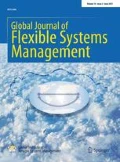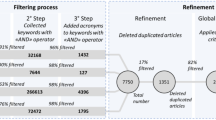Abstract
This paper studies the performance of a flexible manufacturing system under different manufacturing strategies. Manufacturing strategies under consideration are manufacturing flexibility, lot size and scheduling of jobs in the system. The impact of all these strategies is evaluated on the make-span performance of the flexible manufacturing system. The methodologies involved include simulation, Taguchi experimental design and analyzing the results with help of ANOVA. Number of different simulation models is developed with the help of JAVA language. The first model relates to the manufacturing system, which is conventional in nature without any flexibility embedded in the system. The second model takes into partial manufacturing flexibility in the form of routing flexibility. Finally, the third models incorporate much higher level of routing flexibility. All these models are further evaluated at different level of part mix flexibility. Also the scheduling of parts is considered with the objective of minimizing the total make-span time of parts. The results show that considering different manufacturing strategies decisions in a simultaneous manner can significantly improve the performance of the flexible manufacturing systems.



















Similar content being viewed by others
References
Abou G. M., Motavalli, S., Nawara, G., Reyad, A. (2000). An integrated planning system for tool management and part scheduling in FMS. In 4th International conference on engineering design and automation, Orlando, FL.
Alcaide, D., Gonzates, A. R., & Silcilik, J. (2006). A heuristic approach to minimize expected makespan in open shops subject to stochastic processing times and failures. International Journal of Flexible Manufacturing System, 17(3), 201–226.
Ali, M. (2012). Impact of routing and pallet flexibility on flexible manufacturing system. Global Journal of Flexible Systems Management, 13(3), 141–149.
Ali, M. (2013). Information based decision and control in flexible manufacturing systems. Industrial Engineering Journal, 6(6), 12–19.
Ali, M., Salahuddin, & Khan, M. A. (2010). Analysis of the impact of routing flexibility on the performance of flexible system. International Journal of Industrial Engineering, 17(4), 269–278.
Ali, M., & Wadhwa, S. (2005). Performance analysis of partial flexible manufacturing system. Global Journal of Flexible Systems Management, 6(1), 9–19.
Ali, M., & Wadhwa, S. (2010). The effect of routing flexibility on a flexible system of integrated manufacturing. International Journal of Production Research, 48(19), 5691–5709.
Azimi, P., Haleh, H., & Alidoost, M. (2010). The selection of the best control rule for a multiple-load AGV system using simulation and Fuzzy MADM in a flexible manufacturing system. Modelling and Simulation Engineering, 2010, 1–11.
Barad, M., & Sapir, D. E. (2003). Flexibility in logistic systems modeling and performance evaluation. International Journal of Production Economics, 85(2), 155–170.
Benjaafar, S. (1994). Models for performance evaluation of flexibility in manufacturing system. International Journal of Production Research, 2(6), 1383–1402.
Boctor, F. F., Renaud, J., Ruiz, A., & Tremblay, S. (2009). Optimal and heuristic solution methods for a multi processor machine scheduling problem. Computers & Operations Research, 36(10), 2822–2828.
Bonney, M., & Jaber, M. J. (2013). Developing an input–output activity matrix (IOAM) for environmental and economic analysis of manufacturing systems and logistics chains. International Journal of Production Economics, 143, 589–597.
Browne, J. D., Dubois, K. R., Seth, S. P., & Stecke, K. E. (1984). Classification of flexible manufacturing systems. The FMS Magazine, 2(2), 114–117.
Bruce, W., & Albert, L. (1999). A strategic investment model for phased implementation of flexible manufacturing systems. International Transaction in Operational Research, 6, 331–344.
Caprihan, R., & Wadhwa, S. (1997). Impact of routing flexibility on the performance of an FMS—A simulation study. International Journal of Flexible Manufacturing Systems, 9, 273–298.
Cesar, C., & Ana, V. L. (2010). An examination of the relationship between manufacturing flexibility and firm performance: The mediating role of innovation. International Journal of Operations & Production Management, 30(8), 853–878.
Chan, F. T. S. (2001). The effects of routing on a manufacturing system. International Journal of Computer Integrated Manufacturing Systems, 14(5), 431–445.
Chan, F. T. S. (2004). Impact of operation flexibility and dispatching rules on the performance of a flexible manufacturing system. International Journal of Advanced Manufacturing Technology, 24(5/6), 447–459.
Chan, F. T. S., Bhagwat, R., & Wadhwa, S. (2008). Comparative performance analysis of a flexible manufacturing system: A review-period-based control. International Journal of Production Research, 46(1), 1–24.
Chan, F. T. S., & Chan, H. K. (2004). A comprehensive survey and future trend of simulation study on FMS scheduling. Journal of Intelligent Manufacturing, 15, 87–102.
Chan, F., & Swarnkar, R. (2006). Ant colony optimization approach to a fuzzy goal programming model for a machine tool selection and operation allocation problem in an FMS. Robotics and Computer-Integrated Manufacturing, 22, 353–362.
Elmekkawy, T. Y., & Elmaraghy, H. A. (2003). Efficient search of petri nets for deadlock-free scheduling in FMSs using heuristic functions. International Journal of Computer Integrated Manufacturing, 1, 14–24.
Hamid, U. (2010). Petri net versus queuing theory for evaluation of flexible manufacturing system. Advances in Production Engineering and Management, 5, 93–100.
He, N., Zhang, D. Z., & Li, Q. (2014). Agent-based hierarchical production planning and scheduling in make-to-order manufacturing system. International Journal of Production Economics, 149, 117–130.
Hlupic, V., & Paul, R. J. (1994). Simulation modelling of flexible manufacturing systems using activity cycle diagrams. Journal of Operational Research Society, 45(9), 1011–1023.
Joseph, O. A., & Sridharan, R. (2011). Effects of routing flexibility, sequencing flexibility and scheduling decision rules on the performance of a flexible manufacturing system. International Journal of Advanced Manufacturing Technology, 56, 291–306.
Koulumas, C., & Kyparisis, G. J. (2004). Concurrent flow shop scheduling to minimize makespan. European Journal of Operational Research, 156(2), 524–529.
Lin, G. Y. J., & Solberg, J. J. (1991). Effectiveness of flexible routing control. The International Journal of Flexible Manufacturing System, 3, 189–211.
Nagarjuna, N., Mahesh, O., & Rajgopal, K. (2006). A heuristic based on multistage programming approach for machine-loading problem in a flexible manufacturing system. Robotics and Computer-Integrated Manufacturing, 22(4), 342–352.
Parker, R. P., & Wirth, A. (1999). Manufacturing flexibility: Measures and relationships. European Journal of Operational Research, 118(3), 429–449.
Phadke, M. S. (1989). Quality engineering using robust design. Englewood cliffs, NJ: Prentice Hall International.
Prakash, A., & Deshmukh, S. G. (2011). Modelling of FMS control policy: AIS-based fuzzy expert system. International Journal of Industrial and Systems Engineering, 8(1), 38–60.
Roy, R. K. (1990). A primer on the taguchi method. Van Nostrand Reinhold, New York.
Sabuncuoglu, I., & Lahmar, M. (2003). An evaluation study of operations grouping policies in an FMS. The International Journal of Flexible Manufacturing Systems, 15, 217–239.
Sethi, A. K., & Sethi, S. P. (1990). Flexibility in manufacturing: A survey. The International Journal of Flexible Manufacturing Systems, 2, 289–328.
Shafiq, I. S., Faheem, M., & Ali, M. (2010). Effect of scheduling and manufacturing flexibility on the performance of FMS. Global Journal of Flexible System Management, 11(3), 21–37.
Singholi, A., Ali, M., & Sharma, C. (2012). Impact of manufacturing flexibility on FMS performance: A simulation study. International Journal of Industrial and Systems Engineering, 10(1), 96–116.
Singholi, A., Chhabra, D., & Ali, M. (2010). Towards improving the performance of flexible manufacturing system: A case study. Journal of Industrial Engineering and Management, 3, 87–115.
Stecke, K. E. (1983). Design. Planning, scheduling and control problems of flexible manufacturing system, annals of operational research, 3(1), 1–12.
Wadhwa, S., & Bhagwat, R. (1998). Judicious increase in flexibility and decision automation in semi-computerized flexible manufacturing (SCFM) systems, international, journal. Studies in Informatics and Control, 2(8).
Wadhwa, S., Ducq, Y., Ali, M., & Prakash, A. (2008). Performance analysis of a flexible manufacturing system under planning and control strategies. International Journal, Studies in Informatics and Control, 17(3), 273–284.
Wadhwa, S., Ducq, Y., Ali, M., & Prakash, A. (2009). Performance analysis of flexible manufacturing system. Global Journal of Flexible System Management, 10(3), 23–34.
Yildrim, M. B., Dergue, U., Cakar, T., & Meza, J. C. (2006). Machine number priority rule and due date determination in flexible manufacturing systems using artificial networks. Computers and Industrial Engineering, 50(1/2), 184–194.
Zhang, Q., Vordercmese, M. A., & Lim, J. S. (2003). Manufacturing flexibility defining and analyzing relationship among competence, capacity and customer satisfaction. Journal of Operational Management, 21, 173–191.
Author information
Authors and Affiliations
Corresponding author
Rights and permissions
About this article
Cite this article
Ali, M., Ahmad, Z. A Simulation Study of FMS Under Routing and Part Mix Flexibility. Glob J Flex Syst Manag 15, 277–294 (2014). https://doi.org/10.1007/s40171-014-0071-z
Received:
Accepted:
Published:
Issue Date:
DOI: https://doi.org/10.1007/s40171-014-0071-z




